| Return to main page |
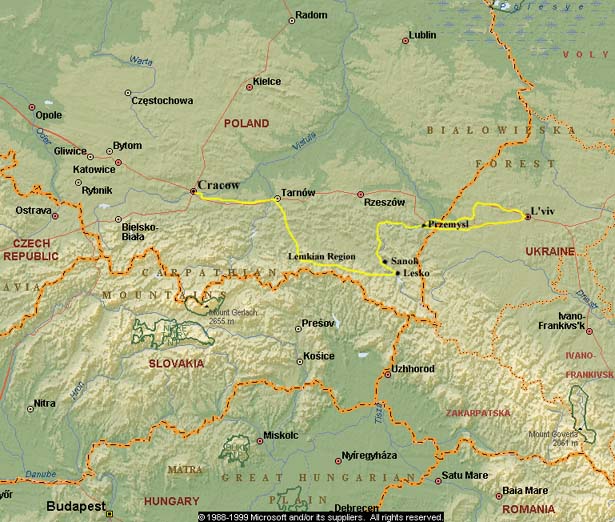
'Fair enough,' assented the Professor. 'It is important, however, to be clear that this unique group has not always been here, that it crystallised over a long period in the later Middle Ages as a result of complicated migratory processes. And we must recognise that, despite having many distinctive elements in their 'folk culture', in the basic ways they make a living and in their religious beliefs they are hardly any different from their neighbours - especially from their neighbours to the east, the people we nowadays call Ukrainians.'
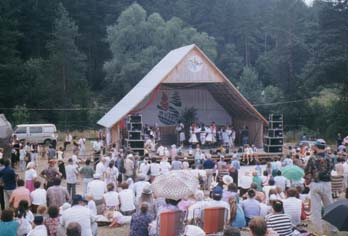 |
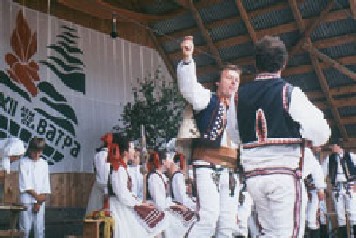 |
Figure 41: The Festival stage and Lemko folk dancing
Tom and Ania thought about this further in the course of the afternoon, as they lay on a grassy slope and enjoyed the performances of a succession of folklore groups on the small wooden stage. From some picnickers sitting nearby they learned that the flag fluttering proudly to the left of the stage was the Ukrainian national flag: why should this enjoy such prominence if the Lemkos did not consider themselves to be Ukrainians? Eventually they fell into conversation in English with some people of their own age, who told them that it was possible to be both Lemko and Ukrainian at the same time. 'Lemko is my ethnic or regional group,' one of them put it, 'but Ukrainian is my nationality.'
When they related this later to their teachers, Dr. Dylagowa nodded and said 'yes, it's like the Górale around Zakopane, who manage to be proud of their regional identity, without this calling into question their basic national identity as Poles.' But the Professor was reluctant to accept this analogy. 'No,' he insisted, 'the Lemko case is more complicated. I had a student who did his dissertation on them a few years ago. He found that some of them are quite convinced that the Lemkos are a separate nation from Ukrainians. They are closely related to other small groups, sometimes known as Ruthenians, scattered across Slovakia, Hungary, Romania and the western fringes of Ukraine. All these groups see themselves as different from the Ukrainian mainstream.'
This part of the conversation was overheard by a burly man who turned out to be a car mechanic from Toronto, who had come over for the summer to visit relatives and participate in this Festival. He tapped the Professor firmly on his chest: 'do you mean to tell me that my family, who've lived in a valley not far east of here for centuries, are not proper Ukrainians? What you're telling these youngsters is just old Polish propaganda, lies that were invented to weaken the Ukrainian independence movement.'
The Professor decided that it was not worth pursuing the argument with this opponent. The subject was rapidly changed, some vodka was produced, and no one succeeded in writing up any field notes that evening.
The Professor returned to the theme first thing next morning, when the students emerged bleary-eyed from their tents. 'You must understand, it is a complex situation. There are people who come from the same village as this man and who insist that they are Lemkos and not Ukrainians. They too have a spokesman in Toronto, namely a University Professor who has helped to explain the distinctive history of the Ruthenians or, as he calls them, the Carpatho-Rusyns, and to make dictionaries and grammar books, to help them appreciate the riches of their own language. Of course, I don't deny that this language, that their culture as a whole, is very close to that of the Ukrainians. But as long as many thousands of Lemkos prefer to see themselves as forming part of a relatively small Ruthenian nation, rather than as part of a vast Ukrainian one, don't they have the right to do so? Even if it's hardly realistic for them to found their own state in this mountainous region, surely they deserve at least to be recognised as a distinct minority, and to have their language taught in local schools?'
'But this name Lemko is an artificial one, invented by a Polish ethnographer in the nineteenth century. This so-called Ruthenian orientation is a direct product of what these peasants have been told by generations of 'experts', ethnographers among them. I can see why most Ukrainians consider all these efforts to build up Lemko and Ruthenian identities as a product of malevolent Polish interference. These mountain dwellers were obviously too different from other West Slavs to be converted into Poles, so instead the Polish authorities who controlled the territory helped to construct this idea of a separate East Slav nation. It just shows you how people can be brainwashed in the age of nationalism. Why do they have to have a national identity at all?'
This was Dr. Dylagowa, but these were very much Ania's thoughts too, as the Festival programme resumed for its second and final day. Tom also found it remarkable that, in the middle of the twentieth century, many people in this region had still been uncertain as to which nationality to call their own. And some of them were still unsure even at the end of the century. The students were introduced to a retired schoolteacher who had devised primary school teaching materials in Lemko, which she was using with a small group of local children. They also met a University lecturer from Cracow who showed them several volumes of her poetry, also written in Lemko. Her dark eyes showed real anger as she explained that this Festival, which had been launched exclusively by Lemkos in the mid-1980s, at a time when such initiatives demanded real political courage, were now being taken over by those who favoured the Ukrainian orientation. Even the Greek Catholic priest who had celebrated open air mass that morning had, said the poetess, used only literary Ukrainian throughout the mass. He had asked God to bless the Ukrainian fatherland but not uttered a single word about the Lemkos. The real Lemko Festival, according to this lecturer, was now organized by a separate group several hundred miles away, in one of the areas to which Lemkos were deported in 1947. It was regrettable that authentic Lemko culture could only be preserved outside the homeland, in a region that used to belong to Germany, while the homeland Festival was increasingly Ukrainianised.
It was a hot day and, after another large lunch and plenty more Zywiec, most of the students began to find the sights, sounds and smells all a bit overwhelming. Ania and Tom had dozed off to sleep when the Professor summoned the group back to the minibus. 'Come along, we've all been invited to a party in the next valley!'
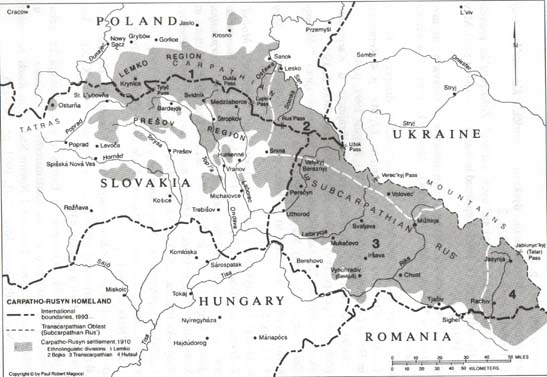
Figure 42: The area inhabited primarily by Carpatho-Rusyns in late Habsburg times (from P. R. Magocsi (ed.), The Persistence of Regional Cultures; Rusyns and Ukrainians in their Carpathian homeland and abroad. (East European Monographs CCCLXV, New York, 1993).
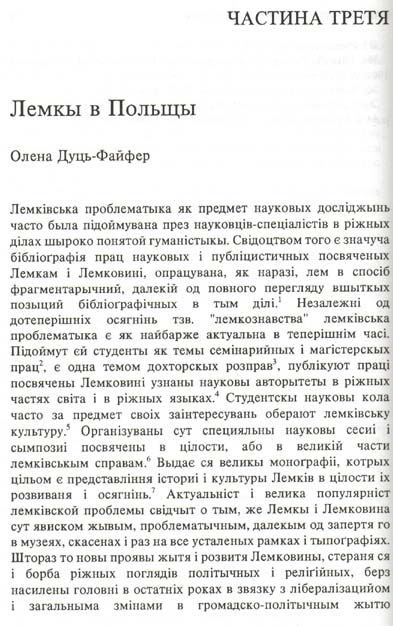
Figure 43: Text Fragment in the Lemko-Rusyn language
(Lemkos in Poland, by Olena Duc'- Fajfer; for the full text in both Lemko-Rusyn and English translation see P. R. Magocsi (ed.), The Persistence of Regional Cultures; Rusyns and Ukrainians in their Carpathian homeland and abroad. (East European Monographs CCCLXV, New York, 1993).
| Return to main page |